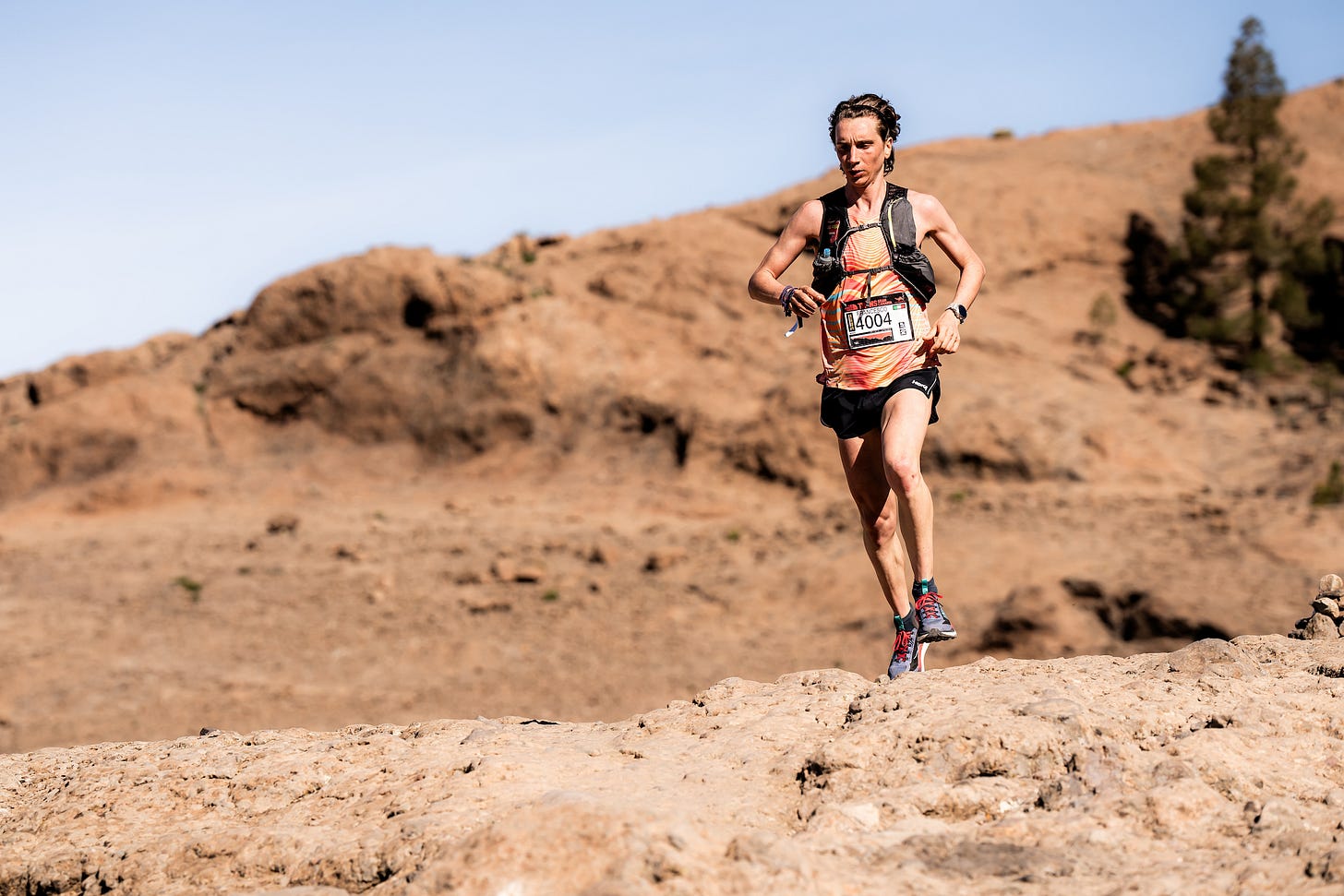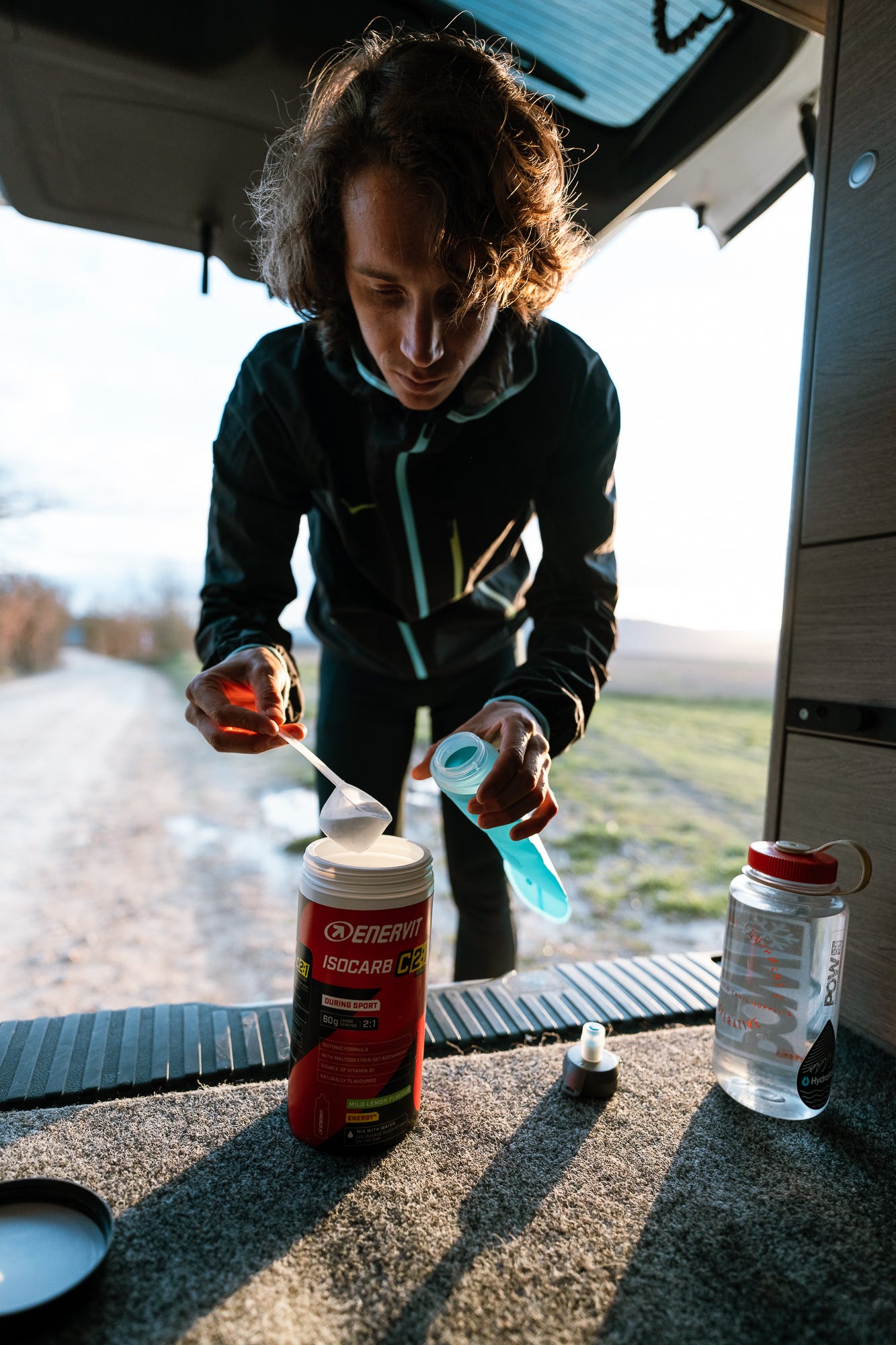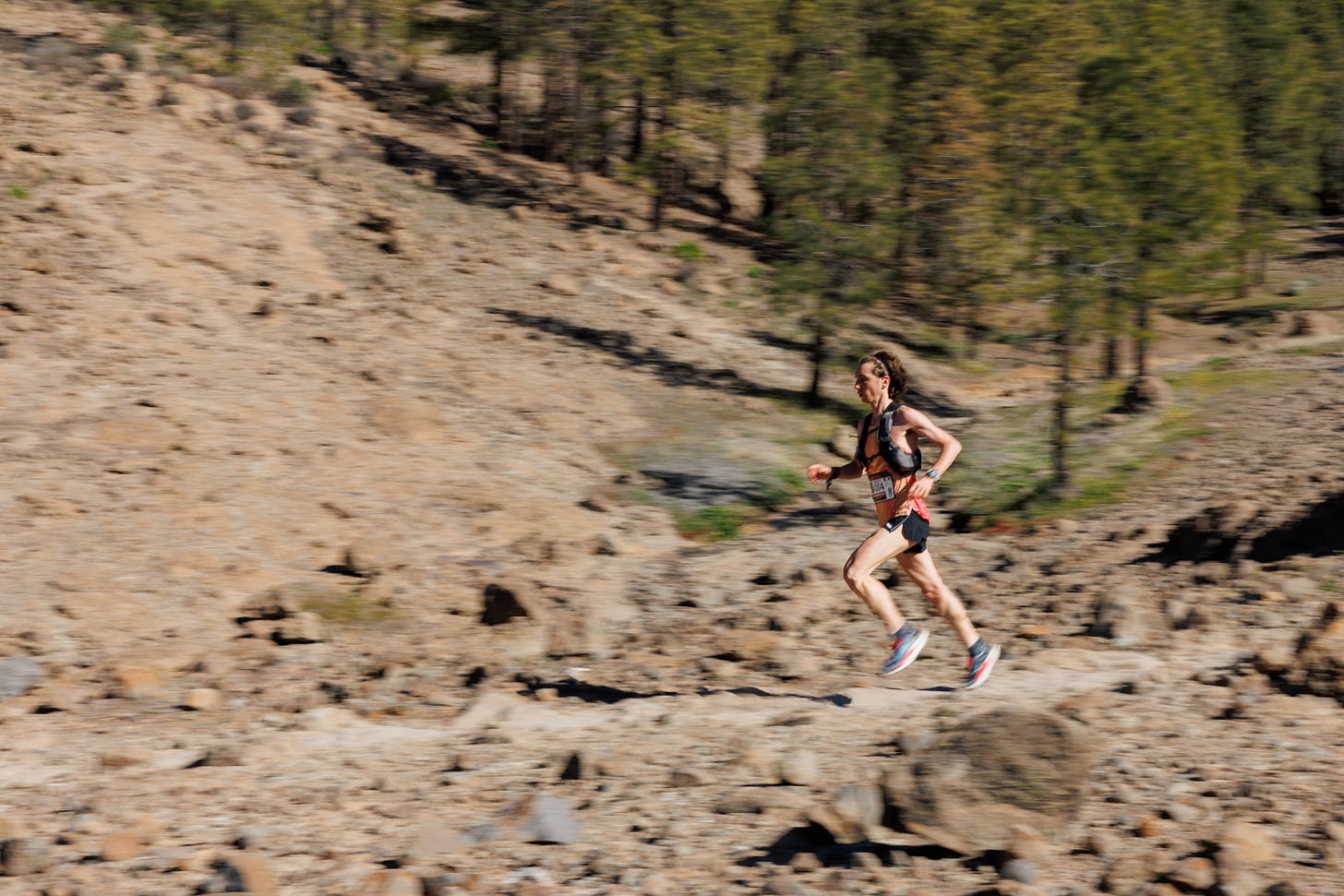Transgrancanaria Marathon: the result
Inspired by Caleb Olson, who wrote a very insightful recap of his race at Transgrancanaria Classic, I decided to share some flight-home reflections after my TGC Marathon win.
Photo: Ian Corless
Going into the race, I felt very confident about my preparation. I must admit, this was unusual for me—it’s something that probably hadn’t happened in years. It’s not that the preparation leading up to TGC was perfect or flawless, but I genuinely felt like I could largely control my response to training, my energy levels, and my mood. I wasn’t merely tolerating or sometimes enduring the training, I was actually adapting to it in an effective way.
I think the sponsorship change, along with a few other small but significant life adjustments, made a difference in the last couple of months. The years I spent running for Nike were definitely very rewarding (I don’t regret anything from that experience), but they quickly transitioned from feeling incredibly lucky to represent the world’s number-one brand, to feeling stuck in a system that didn’t seem to care much about me and my sport, and constantly feeling the need to prove myself worthy of being a Nike athlete. I’ve often underestimated the impact of these boundary conditions, but now I realize how much they must have affected my overall health and wellbeing.
The day before the race, I went out for a 30-minute pre-race shakeout and a few strides. When I checked my watch after about 15 minutes, I was surprised to see I was running at a 3:40/km pace almost effortlessly. I don’t think much about destiny, but I met Caleb Olson towards the end of my run, and we shared a few minutes of cool-down together. It was probably a good sign. I have a lot of respect for Caleb. It was a nice catch-up, and I’m kind of sad that we’re not teammates anymore, though I hope there will be plenty of chances to see each other and share some miles.
The day after, I lined up at the start line with the awareness that for every hour I planned to spend racing, there was a not so small mountain of 60 hours of training behind it. People often emphasize competitions, but the way I see my races is that they’re such brief moments compared to how much time I spend training. How can people obsess so much over the five or six races we run each year, and not really pay attention to the 360 or so days when we’re not racing? The racing to training days ratio is overwhelmingly skewed towards the latter. The way I see it is that of course, on race day, you’ll have the physical and mental strength to perform, if your preparation has been solid. How could you not? What I value much more is the enormous amount of time and work it takes to be able to experience those special days. Life happens on the normal day - the ones that are not so special, the days that don’t make it to your Instagram feed. On one hand, this can be intimidating and challenging, but on the other, it’s what I love most.
Photo: Matias Novo
One kilometer from the start, it was already clear that the race would be between me and Robert Pkemoi. The Kenyan athlete set off at a blistering pace, given the expected 3h30 of effort. I think there’s something in my central governor—a speed limiter, perhaps—that prevents me from going out really hard or doing something stupid at the start of relatively long races. How else can I explain why I’m able to go out much harder in shorter races, but not in long races? It’s almost like my central governor is solving the Schrodinger equation: given certain boundary conditions (mostly based on perceived effort), it predicts how I’m going to feel a certain amount of time ahead.
After the first climbs, I had to let Robert go and settle into my pace. It didn’t feel great, I was definitely feeling heavier than I would have liked. I started having second thoughts like, “You thought your preparation was good, but maybe it wasn’t actually that good…” or, “It’s hard to replicate race pace in training and this is the first race of the year, you’re not used to this intensity.” I don’t remember exactly how I managed to keep these intrusive thoughts at bay, but somehow I did. After a few minutes on the first climb, I couldn’t see Robert ahead of me, nor anyone else behind me.
I met my crew (Filippo and Irene) at the top of the first climb, and I grabbed a flask of water from Filippo. The plan was to pick up most of the fuel I needed for the second half of the race at the halfway aid station in Tunte (km 23). I struggled a bit on the technical, but mostly just slow downhill section (about 500m of elevation loss). I was even passed by Adil Moussaoui, a Moroccan runner who was moving much more efficiently than me on the cobblestones and loose rocks. We were running through a beautiful scenery, with the trees offering shade on the north side of the island giving way to a rocky landscape devoid of vegetation.
Tunte was the turning point of the race and a true test of my mental strength, in a completely unplanned way. I was expecting to see Filippo just before the aid station and was surprised not to see him. I thought, “Okay, he must be right after it”, but few strides later, I realized Filippo wasn’t going to be there. After the race, I learned that traffic had been stopped a few kilometers from Tunte, so Filippo hadn’t been able to reach me. It was too late to turn back and refill my flasks at the aid station. In my mind, I held onto the vain hope that somehow Filippo would take a shortcut and run towards me with the flasks and the gels (2 x 500ml flasks, one with water and one with 60g of Enervit Isocarb, plus 2 x 40g C2:1 PRO Enervit gels, totaling 140g of carbs). That hope lasted a couple of kilometers until it became clear that I had to rely on the bottom of a flask at least until the next aid station.
It was getting warmer, and I was feeling thirsty as we approached midday. I had only drunk 1.5 liters of water since the start, which was essentially two hours earlier. I quickly passed Adil after the aid station and started climbing towards Degolada de la Manzanilla at a good pace. My race strategy never really shifted from “let’s race for the win” to “let’s race to make it to the finish” after what had happened. This was probably a good sign that I was still holding onto some confidence. I cautiously considered the possibility of bonking if I’d pushed too hard, but it never really seemed like a realistic concern. Instead, I focused on efficiency—being smooth and quick on my feet, dancing on the downhills, which I was now approaching much more fluidly, and surging on the climbs.
I knew I had to stop at the aid station in Ayagaures, and in fact, I did. I took time to refill both flasks with water and grabbed a random sports gel from the aid station table. An interviewer put a microphone in my face and asked how I was feeling as I got water. I just said, “I missed my refreshment at the previous aid station,” as I was too focused to say anything else.
I squeezed the gel into my mouth on the steady, gradual 200m climb out of Ayagaures, which would lead to a cliff and the final, long downhill to the finish. It was absolutely disgusting, and felt very little energy-dense compared to the 40g Enervit shots I’m used to, but I knew it would be important to take it. For the first time since the start, I saw Robert on the upper switchback of the climb, maybe a couple of minutes or about 400m ahead of me. I quickly did the math and realized that if I could gain around 8-9 seconds per kilometer, I could catch him just before the finish. Unlikely, but not impossible
Photo: Francesca Grana
I’m used to fueling with high carbs during, before, and after training. I never train in a fasted state or do crazy experiments with food (low carb diets, sodium bicarb and other apparently popular strategies). Training is already hard enough without depriving myself of carbs. Even though I don’t intentionally train my fat metabolism—since carb availability is always high—I believe I’m fairly good at oxidizing fats and using fuel efficiently at relatively high intensities, probably between LT1 and LT2 (the intensity at which I believe I can run a 3-5 hour ultramarathon, as the 50k at Julian Alps proves - it was a race where I took it relatively easy and still spent 54% of the total time in Z3. I don’t usually carry a HR monitor in races). I think this comes from:
Many years of high-volume training, which has made me efficient at using fuel by running lots of easy miles.
Years of underfueling in my youth and early twenties.
I definitely had some eating disorders back then. Until I decided to take care of myself, as I was too tired and desperate to deprive myself of food. At first, it came from an unhealthy feeling of lack of control and desperation. I felt completely fed up with myself, unable to control both what I ate or how I trained. Now, I’ve finally learned that I don’t need to restrict what I eat, and it’s actually detrimental for performance. I don’t need to have the “perfect” athlete body we often idealize. I don’t need to achieve a specific racing weight or body fat percentage. I’ve switched my mindset from “I need to eat less to look like an athlete” to “I need to fuel more to train more.” I still have intrusive thoughts like “I don’t look like an athlete,” or “My quads are too big and chubby,” and I still wonder if I could get away with one less gel during training, one less plate of pasta at lunch, or one less scoop of granola at breakfast. But I’ve mostly learned how to handle these thoughts and feel equipped enough not to be overwhelmed by them.
This may be inaccurate, but I think that something I carry from those years of underfueling (and I want to make it clear: please don’t do this. It’s terrible, it leads to depression, injuries, poor training, and even worse performances, and I totally regret it) is the fact that my body got so used to running on empty that now, when I’m low on sugar, it doesn’t trigger the alarm or slow me down so much, unless it’s really serious. I treated my body so badly—thinking it was the way to train and because I thought I didn’t deserve any better—for so long that now, a race, no matter how hard, feels like a walk in the park compared to what I went through. I’ve often asked myself whether it’s really necessary to go through suffering and self-hate to achieve something widely regarded as successful. I’ve come to a solid conclusion—long story short, it’s absolutely not necessary, and I wouldn’t recommend it to anyone. But this isn’t the place to get into it, and I’ll save that for another time.
Photo: Martin Fettich
For the most part, I just tried to turn off my brain and run. My feet hurt, and I was feeling dehydrated. Any thought I had was mostly about wishing the race would end as soon as possible. I also remember a similar dynamic that Caleb described in his post: what I was doing was supposed to be difficult, it was supposed to hurt, but at the same time, it was just a game.
Sara Alonso had mentioned an unmarked aid station about 5km from the finish. I immediately remembered her message when I saw a white gazebo with a few jars of water and two guys waiting for the runners. I stopped for about 10 seconds to refill a flask, as I was very thirsty. In hindsight, I wish I hadn’t. About a mile later, I started seeing Robert in the distance, maybe 30 or 40 seconds ahead of me.
Ida Sophie Hegemann was there to cheer me on, she confirmed the gap and pushed me to catch Robert. I wasn’t entirely sure I could. I vividly remember negotiating with myself about whether I should dig deeper, giving more than I thought I could, in order to try and catch Robert. I always struggle with these moments in a race. I guess it’s impossible to replicate them outside of competition, which is why experience matters. On one hand you feel a huge drive to win, on the other hand there are no certainties, no assurances that pushing harder is going to allow you to cross that finish line in first. There’s a subtle pleasure in giving up and being content with the second place, coming close enough to victory to make it feel almost within reach, but not quite there.
One of the best feelings in life is knowing you can achieve something but then deliberately choosing not to. A while ago, my friend Filippo Caon asked me if I would accept a golden ticket for Western States at Canyons if I got one. I replied, “No, definitely not,” because racing WS would mess up my calendar for 2025. But also, “It’s a nice feeling to know you can do something and then not do it, right?” I don’t really know why this feeling is so appealing to me, but it is.
Video: Davide Barone
People were cheering me on, and the camera biker filming Robert was getting closer. I ran as fast as I could on the riverbed and gravel towards Parque del Sur, where the finish awaited. The last section of the Transgrancanaria course isn’t particularly scenic: it goes under a couple of bridges, then emerges from a riverbed onto a road that skirts a few tennis courts before turning right into Parque del Sur.
Robert was speeding up, trying to maintain his lead, and I realized that the gap between us wasn’t closing as quickly as before. The final meters were intense, and I don’t have a clear memory of what happened. I think that when the physical effort becomes overwhelming, our brains shut down a bit trying to conserve energy. It’s probably an evolutionary response. Nature always finds the most efficient way. I’ll let the images speak for themselves.
My finish time was 3:23:26, 18 seconds ahead of Robert Pkemoi and 7:36 ahead of Tiago Vieira, a young Portuguese talent to definitely keep an eye on. My COROS recorded 46.59 km at an average pace of 4:22 per km, with a Strava GAP of 3:47. I estimated we could run between 3:20 and 3:30 before the race, but with no precise idea of the course’s technicality, I was surprised by how fast we ran. I finished the last 3 km at a 3:17/km pace, the final km at 3:12/km (coming out of the riverbed), and the last 400m at 2:58/km. The performance earned me 938 ITRA points, however it’s worth. My friend Henri ran the longest race of his life and placed 9th in 3h37, a great result that definitely gives him some motivation to improve and insist in this direction.
It’s been an incredible experience on the island of Gran Canaria, where time slows down, skies are clear, temperatures are mild, and sunsets feel endless. I was so happy to share the first trip of the year with Filippo, with whom we’ve worked so hard to get to where we are now after countless emails, meetings, and calls. It’s been incredibly rewarding to get to know each other, learn from one another, and share knowledge, passion and some fun.
I know Filippo still feels bad for missing the aid station in Tunte and not fulfilling his crewing duties, but I told him there’s no need to feel guilty. There’s no reason for it. The experience is complete as it is, and it has probably taught us something valuable. A win can happen when favorable conditions align, when the pre-conditions come together, and you’re able to enter a state of focus where both your strengths and vulnerabilities produce excellence (not perfection), allowing you to push further than you think you can.











Loved this write up and getting to spend a little time with you out on the island. Watching your marathon finish the previous day kept it fresh in my head that the race isn’t over til it’s over, and you have to keep pushing to the very end. Thanks for sharing!
This story tells much more than a race, tells how to manage dysfunctional thoughts, tells about nutrition, adaptive abilities and eating disorders in sport. Should read it all those who do sports.
I hope to read more about your athletic history here or listen it in your podcast.
Thanks for sharing.